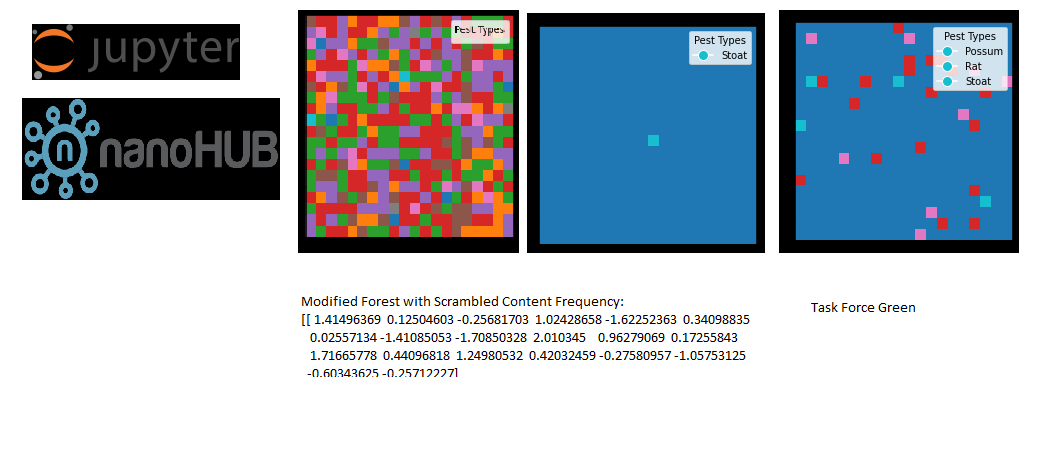import matplotlib.pyplot as plt
import numpy as np
def create_forest(rows, cols, pest_ratios):
“”“Create a forest with pests based on specified ratios.”“”
forest = np.zeros((rows, cols))
total_cells = rows * cols
for pest_type, ratio in pest_ratios.items():
num_pests = int(total_cells * ratio)
pest_locations = np.random.choice(total_cells, num_pests, replace=False)
for loc in pest_locations:
row, col = divmod(loc, cols)
forest[row, col] = pest_type
return forest
def plot_forest(forest, title=‘Forest Scenario’, cmap=‘tab10’):
“”“Plot the forest using Matplotlib.”“”
plt.imshow(forest, cmap=cmap, interpolation=‘nearest’)
plt.title(title)
plt.xlabel(‘Columns’)
plt.ylabel(‘Rows’)
# Add legend
legend_labels = {1: 'Possum', 2: 'Rat', 3: 'Stoat'}
unique_labels = np.unique(forest)
legend_elements = [plt.Line2D([0], [0], marker='o', color='w', markerfacecolor=plt.cm.tab10(i),
markersize=10, label=legend_labels[i]) for i in unique_labels if i in legend_labels]
plt.legend(handles=legend_elements, title='Pest Types')
plt.show()
def simulate_content_frequency(forest, mean=0, std=1):
“”“Simulate content frequency to scramble the forest.”“”
scramble_frequency = np.random.normal(mean, std, forest.shape)
return forest + scramble_frequency
def catch_pests(forest, trap_ranges, bait_location=None, trap_open=True):
“”“Implement multiple trapping methods with changing bait frequency.”“”
caught_pests = np.zeros_like(forest)
# Use bait if specified
if bait_location:
bait_row, bait_col = bait_location
caught_pests[bait_row, bait_col] = 3 # Mark the bait location
# Check if the trap is open
if trap_open:
for trap_range in trap_ranges:
# Iterate through each cell in the forest
for row in range(forest.shape[0]):
for col in range(forest.shape[1]):
if forest[row, col] in [1, 2]: # Mark possums and rats
# Mark the caught pests within the trapping range
caught_pests[max(0, row - trap_range):min(forest.shape[0], row + trap_range + 1),
max(0, col - trap_range):min(forest.shape[1], col + trap_range + 1)] = 1
elif forest[row, col] == 3: # Mark stoats
# Mark the caught stoats within the trapping range
caught_pests[max(0, row - trap_range):min(forest.shape[0], row + trap_range + 1),
max(0, col - trap_range):min(forest.shape[1], col + trap_range + 1)] = 2
return caught_pests
Define forest dimensions
rows, cols = 20, 20
Specify the desired pest ratios (adjust as needed)
pest_ratios = {1: 0.05, 2: 0.02, 3: 0.01} # 1: Possum, 2: Rat, 3: Stoat
Create and plot the original forest based on specified ratios
forest_scenario = create_forest(rows, cols, pest_ratios)
plot_forest(forest_scenario, title=‘Original Forest Scenario’, cmap=‘tab10’)
Simulate content frequency to scramble (modify as needed)
forest_with_scrambled_content = simulate_content_frequency(forest_scenario)
print(“Modified Forest with Scrambled Content Frequency:”)
print(forest_with_scrambled_content)
Plot the modified forest scenario
plot_forest(forest_with_scrambled_content, title=‘Modified Forest Scenario’, cmap=‘tab10’)
Implement multiple trapping methods with bait and plot the result
trap_ranges = [3, 4, 5] # Specify the trapping ranges for each trap
bait_location = (10, 10) # Specify the location of the bait
Use multiple trapping methods with changing bait frequency
caught_pests = catch_pests(forest_with_scrambled_content, trap_ranges, bait_location=bait_location)
plot_forest(caught_pests, title=‘Pests Caught by Multiple Trapping Methods with Changing Bait Frequency’, cmap=‘tab10’)
